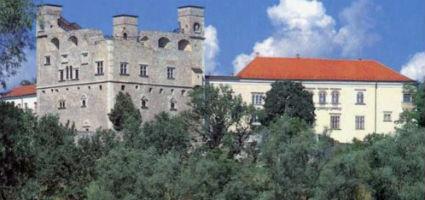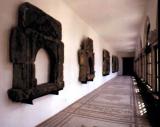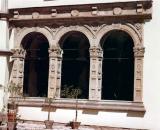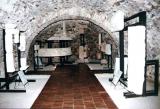2025. July 9. Wednesday
Rákóczi Museum - Sárospatak
 |
Address: 3950, Sárospatak Szent Erzsébet utca 19.
Phone number: (47) 311-083
E-mail: info@rakoczimuzeum.hu
Opening hours: Tue-Sun 10-18
Open on bank holidays! |
Patak, built at the crossing point of the river Bodrog, had been a royal property since the 11th centuary. As his letters say, Péter Perényi built a new residence for his family between 1534 and 1541.
The southern part of the centre of the medieval town was sorrunded by walls and trenches. At the South-East edge of this area there stood a 5 floor tower. Connection made to the town wall and the loop-holes prove that the wall and the tower were built at the same time and in the same style.
The building of the town was designed and directed according to the sketches of the Italian Alessandro Vedani, and accomplished by skilled Hubgarian craftsmen. The Eastern wing, called the Perényi-wing, was built between 1540 and 1567. After 1573 the building works of the castle was continued by the Dobó family and then (after 1608) Mihály Lorántffy owned and continued the building.
The year 1616 was a turning point in the fate of the castle. The owner Zsuzsanna Loránffy got married to György Rákóczi prospective Transsylvanian Prince. That is how Patak became the centre of the Rákóczi property and the connecting link between the Royal Hungary and Transsylvania.
Since 1640 the owners had been extending the castle according to their rank. They built up the outhern wing, the loggia and the cannon terrace. After 1666 Ferenc Rákóczi I and his mother, later Ferenc Rákóczi II and Juliet became the owners of the castle, but in 1670 the imperial army occupied it.
Regardless of this Patak became the centre of the insurrectionist movements, because Ilona Zrínyi and her husband visited and stayed at the castle several times, and because in 1697 the town became one of the fortresses of the uprising in the area. In 1708, during the Rákóczi revolution, the Parliament for the emancipation of serfs was held here.
In 1711 Prince Trautsohn became the new owner, He renovated the castle according to the baroque style. In 1807 the castle was transmitted to the Bretzenheim family that renovated it. Although they kept the 16-17th centary character of the castle, they made romantic and eclectic decorations in the front walls.
In 1875 Princes Windischgrätz, and after the second worls war the Hungarian government became the owners of the castle. The museum has been protecting the Rákóczi inheritance since 1950.
The southern part of the centre of the medieval town was sorrunded by walls and trenches. At the South-East edge of this area there stood a 5 floor tower. Connection made to the town wall and the loop-holes prove that the wall and the tower were built at the same time and in the same style.
The building of the town was designed and directed according to the sketches of the Italian Alessandro Vedani, and accomplished by skilled Hubgarian craftsmen. The Eastern wing, called the Perényi-wing, was built between 1540 and 1567. After 1573 the building works of the castle was continued by the Dobó family and then (after 1608) Mihály Lorántffy owned and continued the building.
The year 1616 was a turning point in the fate of the castle. The owner Zsuzsanna Loránffy got married to György Rákóczi prospective Transsylvanian Prince. That is how Patak became the centre of the Rákóczi property and the connecting link between the Royal Hungary and Transsylvania.
Since 1640 the owners had been extending the castle according to their rank. They built up the outhern wing, the loggia and the cannon terrace. After 1666 Ferenc Rákóczi I and his mother, later Ferenc Rákóczi II and Juliet became the owners of the castle, but in 1670 the imperial army occupied it.
Regardless of this Patak became the centre of the insurrectionist movements, because Ilona Zrínyi and her husband visited and stayed at the castle several times, and because in 1697 the town became one of the fortresses of the uprising in the area. In 1708, during the Rákóczi revolution, the Parliament for the emancipation of serfs was held here.
In 1711 Prince Trautsohn became the new owner, He renovated the castle according to the baroque style. In 1807 the castle was transmitted to the Bretzenheim family that renovated it. Although they kept the 16-17th centary character of the castle, they made romantic and eclectic decorations in the front walls.
In 1875 Princes Windischgrätz, and after the second worls war the Hungarian government became the owners of the castle. The museum has been protecting the Rákóczi inheritance since 1950.


